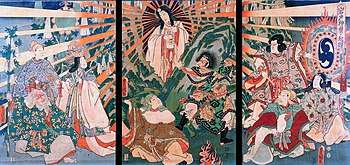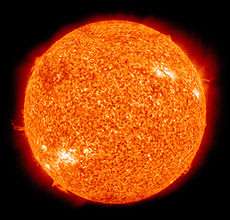List of solar deities
A solar deity is a god or goddess who represents the Sun, or an aspect of it, usually by its perceived power and strength. Solar deities and Sun worship can be found throughout most of recorded history in various forms. The following is a list of solar deities:
African
- Anyanwu, Igbo god believed to dwell in the Sun
- Magec, Tenerife goddess of the sun and light
- Mawu, Dahomey goddess associated with the Sun and the Moon
- uMvelinqangi, Xhosa and Zulu people's god of the sun and sky
- iNyanga, Zulu people, goddess of the moon
- Ukhulukhulwanaa star, Zulu people's ancestor who came from the stars. He taught them to build huts and taught them the high laws of isiNtu
Egyptian mythology
- Amun, creator deity sometimes identified as a sun god
- Aten, god of the sun, the visible disc of the Sun
- Atum, the "finisher of the world" who represents the Sun as it sets
- Bast, cat goddess associated with the Sun
- Hathor, mother of Horus and Ra and goddess of the sun
- Horus, god of the sky whose right eye was considered to be the Sun and his left the Moon
- Ptah, god of craftsmanship, the arts, and fertility, sometimes said to represent the Sun at night
- Ra, god of the sun
- Sekhmet, goddess of war and of the sun, sometimes also plagues and creator of the desert
- Sopdu, god of war and the scorching heat of the summer sun
American
Aztec mythology
- Huitzilopochtli, god of the sun and war
- Nanahuatzin, god of the sun
- Teoyaomicqui, god of lost souls, the sun, and the sixth hour of the day
- Tonatiuh, god of the sun and ruler of the heavens
Brazilian mythology
- Guaraci, god of the sun (Guarani mythology)
- Meri, folk hero and god of the sun
Incan mythology
- Inti, god of the sun and patron deity of the Inca Empire
- Ch'aska ("Venus") or Ch'aska Quyllur ("Venus star") was the goddess of dawn and twilight, the planet
Inuit mythology
Maya mythology
- Ah Kin, god of the sun, bringer of doubt, and protector against the evils associated with darkness
- Hunahpu, one of the Maya Hero Twins; he transformed into the Sun while his brother transformed into the Moon
- Kinich Ahau, god of the sun
Native American mythology
Asian
Ainu mythology
- Chup Kamui, a lunar goddess who switched places with her brother to become goddess of the sun
Arabian mythology
Canaanite mythology
- Shapash, goddess of the sun
Elamite
- Nahundi, god of the sun and law
Hittite mythology
- Istanu, goddess/god of the sun and judgment
- Sun goddess of Arinna
- Sun god of Heaven, daylight god of judgement
- Sun goddess of the Earth, infernal goddess of the underworld.
Japanese mythology

Amaterasu emerging out of a cave, bringing sunlight back to the universe.
- Amaterasu, goddess of the sun
Mesopotamian mythology
Scythian religion
- Tabiti, ancient iranian goddess possibly connected with the sun.
Persian mythology
- Mithra, often associated with the sun.
- Hvare-khshaeta, the sun yazata
Zunism
- The Zunbil dynasty and the subjects of Zabulistan worshiped the Sun, which they called Zun. They believed that the Sun was the god of justice, the force of good in the world and, consequently, the being that drove out the darkness and allowed man to live another day.
European
Armenian mythology
- Ar, Arev, the sun god with its people as "children of the sun"
Baltic mythology
- Saulė, goddess of the sun
Basque mythology
- Ekhi, goddess of the sun and protector of humanity
Celtic mythology
- Áine, Irish goddess of love, summer, wealth, and sovereignty, associated with the Sun and midsummer
- Alaunus, Gaulish god of the sun, healing, and prophecy
- Belenos, Gaulish god of the sun
- Étaín, Irish sun goddess
- Epona, horse deity occasionally linked with Étaín
- Grannus, god associated with spas, healing thermal and mineral springs, and the Sun
- Macha, "sun of the womanfolk" and occasionally considered synonymous with Grian
- Olwen, female figure often constructed as originally the Welsh sun goddess
- Sulis, British goddess whose name is related to the common Proto-Indo-European word for "Sun" and thus cognate with Helios, Sól, Sol, and Surya and who retains solar imagery, as well as a domain over healing and thermal springs. Probably the de facto solar deity of the Celts.
Finnish mythology
- Päivätär, goddess of the sun
Germanic mythology
- Sól/Sunna/Sunne, the common sun goddess among the Germanic tribes, from Proto-Germanic Sōwilō; was chased across the sky in her horse-drawn chariot by a wolf
Lusitanian mythology
- Endovelicus, god of health and safety, worshiped both as a solar deity and a chthonic one
- Neto, claimed to be both a solar and war deity
- A possible sun goddess, whose cult has become that of Virgin Mary Nossa Senhora de Antime.[7][8][9]
Sami mythology
- Beiwe, goddess of the sun, spring, fertility, and sanity
Oceania
Australian Aboriginal mythology
- Bila, cannibal sun goddess of the Adnyamathanha
- Gnowee, solar goddess who searches daily for her lost son; the light of her torch is the Sun
- Wala, solar goddess
- Wuriupranili, solar goddess whose torch is the Sun
- Yhi, Karraur goddess of the sun, light and creation
Māori mythology
- Tama-nui-te-rā, personification of the Sun
See also
References
- J. F. Breton (Trans. Albert LaFarge), Arabia Felix From The Time Of The Queen Of Sheba, Eighth Century B.C. To First Century A.D., 1998, University of Notre Dame Press: Notre Dame (IN), pp. 119-120.
- Julian Baldick (1998). Black God. Syracuse University Press. p. 20. ISBN 0815605226.
- Merriam-Webster, Merriam-Webster's Encyclopedia of World Religions, 1999 - 1181 páginas
- J. Ryckmans, "South Arabia, Religion Of", in D. N. Freedman (Editor-in-Chief), The Anchor Bible Dictionary, 1992, Volume 6, op. cit., p. 172
- http://sino-platonic.org/complete/spp259_tocharian_origins.pdf
- http://www.sino-platonic.org/complete/spp118_chinese_weaving_goddess.pdf
- "UM CULTO SOLAR OU RITUAL DE FECUNDIDADE". Archived from the original on 2011-12-30. Retrieved 2019-01-25.
- "Enciclopédia das Festas Populares e Religiosas de Portugal". p. 64.
- "TEÓFILO BRAGA. O POVO PORTUGUEZ NOS SEUS COSTUMES, CRENÇAS E TRADIÇÕES II".
- Evidence of Minoan Astronomy and Calendrical Practises
- Marinatos, Nanno. Minoan Kingship and the Solar Goddess: A Near Eastern Koine (2013).
This article is issued from Wikipedia. The text is licensed under Creative Commons - Attribution - Sharealike. Additional terms may apply for the media files.

